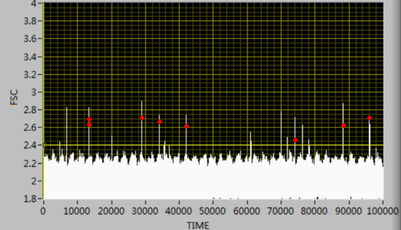- Subscribe to RSS Feed
- Mark Topic as New
- Mark Topic as Read
- Float this Topic for Current User
- Bookmark
- Subscribe
- Mute
- Printer Friendly Page
when the SNR is low, how to improve peak detect result
03-14-2019 06:16 AM
- Mark as New
- Bookmark
- Subscribe
- Mute
- Subscribe to RSS Feed
- Permalink
- Report to a Moderator
There are some points that missed by the peak detector, but if i lower the threshold or width, the higher signal counted double peaks. i guess that's due to the low SNR. cause in the picture below, the peak detector is well function. so how should i improve the peak detection?
03-14-2019 08:54 AM
- Mark as New
- Bookmark
- Subscribe
- Mute
- Subscribe to RSS Feed
- Permalink
- Report to a Moderator
It's pretty difficult to make suggestions from a picture of the output of your program. We would need the Program (as code that we could run, observe, and "attempt to improve") and the data set that you used to produce the pictures you showed. It is impossible to tell if there is a problem, much less where it might be or to suggest how to correct it.
Bob Schor
03-14-2019 10:34 AM
- Mark as New
- Bookmark
- Subscribe
- Mute
- Subscribe to RSS Feed
- Permalink
- Report to a Moderator
How can I improve the CO2 levels in my car's output?
You get the picture (pun intended)?
(Mid-Level minion.)
My support system ensures that I don't look totally incompetent.
Proud to say that I've progressed beyond knowing just enough to be dangerous. I now know enough to know that I have no clue about anything at all.
Humble author of the CLAD Nugget.
03-14-2019 03:23 PM
- Mark as New
- Bookmark
- Subscribe
- Mute
- Subscribe to RSS Feed
- Permalink
- Report to a Moderator
Zip -- right over my head (but a very nice picture ...).
Bob Schor
03-14-2019 08:38 PM
- Mark as New
- Bookmark
- Subscribe
- Mute
- Subscribe to RSS Feed
- Permalink
- Report to a Moderator
sorry, I thought that is a common topic of signal processing. I guess there are solutions like some kind of filter. but the noises contain various frequency, i tried filter, but not good.
Thanks
03-14-2019 09:21 PM
- Mark as New
- Bookmark
- Subscribe
- Mute
- Subscribe to RSS Feed
- Permalink
- Report to a Moderator
The noise is quite constant and your "peaks" seem extremely sharp and easily distinguishable from the noise with a simple threshold detector. Any "filtering" would broaden them into oblivion, making detection more difficult. What else do you know about the peak shape (gaussian, lorentzian, rectangular, etc.) Do the peaks vary in area? What is their origin? Do you have the wavelet toolkit?
In any case, the more you know about the signal, the easier it will be to separate the interesting parts from noise. Tell us as much as you can!
03-14-2019 09:35 PM
- Mark as New
- Bookmark
- Subscribe
- Mute
- Subscribe to RSS Feed
- Permalink
- Report to a Moderator
Also, your VI is not useful to us. Attach relevant data instead.



